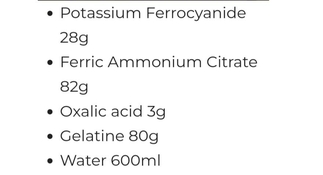Ok, see how it works out with the gelatine without the sensitizer. If that dries without any bubbles, I would also be tempted to test a few plates with just the gelatin and the oxalic acid. If that works OK, test a batch with gelatin, oxalic acid and ferricyanide and a separate batch with gelatin, oxalic acid and citrate. By this time you will know exactly when/where the problem occurs, which should help nail it down. If I were to put any money on this, I would say it's either the oxalic acid that foams in combination with the gelatin, or it's just the gelatin by itself possibly due to bacteria or yeast (so fermentation, in effect). But I'd start by establishing trying to isolate specific factors.
How do you clean your glass plates, BTW? When coating with gelatin for other purposes than cyanotype, I usually just do it the way they do it for wet plate collodion: wash with soap, then scrub/polish with a paste of water + calcium carbonate, then rinse that off (you need to wipe it a bit under a running faucet to get the thin veil of carbonate off entirely). This yields a perfectly clean plate to which stuff like gelatin, but also collodion, gum arabic and albumen will stick well.
After cleaning the glass, do you sub it with a thin layer of e.g. gum arabic or albumen? Just running the glass through a 1% solution of either and then letting it run off works well. Heavier layers of gelatin will adhere to the glass much better this way than without any subbing. However, this mostly helps combating issues like frilling along the edges; your problem seems to be a different one.
PS: there's a typo in the recipe you use. It should be ferricyanide, not ferrocyanide. Ferrocyanide also exists, but doesn't work to the best of my knowledge!













